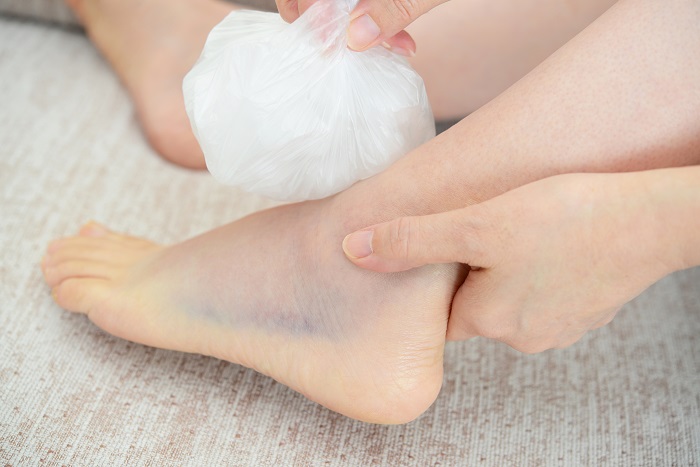Getting an ankle sprain can be painful and depending on the severity of this common injury, the road back to full recovery could be just a couple of weeks or even a few months. Whether playing sports or simply stepping off the curb from a sidewalk, people can sprain their ankle when they suddenly twist, roll, or turn their foot in an awkward way that forces the ankle joint out of its normal position.
To put into perspective the prevalence of ankle sprain injuries, the American Orthopedic Foot & Ankle Society reports that everyday 25,000 people sprain their ankle.
This article is intended to address the role of the Physiotherapist in diagnosing and treating ankle injuries and how patients can benefit from their expertise as they seek a path to rehabilitation.
The Anatomy of an Ankle Sprain
A basic review of human anatomy reveals that there are 26 bones in each human foot and that the ankle joint is attached to three adjoining bones. According to an article from WebMD, an explanation of how the ankle joint is connected with the foot includes the following:
- The tibia, which is the main bones of the lower leg, makes up the medial or inside of the ankle joint.
- The Fibula is the smaller bones that parallels the tibia in the lower leg and makes up the lateral or outside of the ankle joint.
- The far ends of both the tibia and fibula are known as the malleoli (singular is malleolus). Together they form an arch that sits on top of the talus, one of the bones of the foot.
These 3 bones (tibia, fibula, and talus) make up the bony elements of the ankle joint.
The WebMD article goes on to state that when the ligaments surrounding the ankle bone give way and ultimately tear, then the result is a sprained ankle. In relation to the onset of where an ankle sprain occurs, lateral ankle sprains are among the most common.
In fact, according to an article in Physiopedia titled “Lateral Ligament Injury of the Ankle,” it states that “Lateral ankle sprains are referred to as inversion ankle sprains or as supination ankle sprains. It is usually the result of a forced plantarflexion/inversion movement, the complex of ligaments on the lateral side of the ankle is torn by varying degrees.”
Someone who twist or turn their ankle may think “It hurts a little, but it’s not that serious.” However, there may be a range of symptoms that occur after injuring an ankle and if ignored, can make the situation considerably worse. For example, the Mayo Clinic emphasises that while “treatment for a sprained ankle depends on the severity of the injury,” there are some important signs and symptoms that people should be aware of that include:
Symptoms of Ankle Sprains
 There are a number of symptoms of ankle sprains including:
There are a number of symptoms of ankle sprains including:
- Pain, especially when you bear weight on the affected foot
- Tenderness when you touch the ankle
- Swelling
- Bruising
- Restricted range of motion
- Instability of the ankle
- Popping sensation or sound at the time of injury
The above examples demonstrate that suffering from a lateral ankle injury can be debilitating and painful, especially for people who don’t take a proactive stance in pursuing a treatment and recovery plan. In referencing the term “convolute” (twist), HowtoRelief provides the following examples of causes associated with ankle sprains:
- Ambulating (walking) or exercising on an uneven surface
- Falling down
- Participating sports that require cutting actions or rolling and convoluting of the foot – such as trail running, tennis, football, basketball, and soccer
- During sports, someone else may step on your foot while you are running, causing your foot to convolute or roll to the side.
It is common knowledge that people who sustain ankle injuries are not relegated to sports-specific activities, as this is an injury that can occur just from the simple act of walking.
The role of a Physiotherapist can be instrumental in treating ankle sprains. Patients who are committed to being pain-free and regaining their normal quality of life often experience huge benefits from visiting their local Physiotherapist.
Physiotherapists and the Treatment of Ankle Sprains
 Physiotherapists are experienced in assessing and diagnosing the severity of an ankle sprain for the purpose of deploying a patient-specific treatment and rehabilitation program. An acute lateral ankle sprain causes pain and the reality that emerges from this injury is a temporary period of reduced functioning and disability.
Physiotherapists are experienced in assessing and diagnosing the severity of an ankle sprain for the purpose of deploying a patient-specific treatment and rehabilitation program. An acute lateral ankle sprain causes pain and the reality that emerges from this injury is a temporary period of reduced functioning and disability.
Hence, early management and follow-up treatment can accelerate the healing process and lead to a return to desired activities. Unfortunately, many patients don’t receive supervised, professionally administered care and face the possibility of an unnecessarily prolonged recovery process, and even permanent instability which significantly increases the risk of future sprains.
Broken down into two areas of importance, treatment of lateral ankle sprains should incorporate Physio-management and self-management care. In physio-management, it is vitally important that a patient see a Physiotherapist to receive a proper diagnosis and treatment options. According to SportsCare, a Physiotherapist can help a patient return to normal function by doing the following:
- Program to strengthen muscles around the joint
- Balance and proprioception training to help improve overall function of the joint (shown in the image above)
- Graded and safe return to sport/work to minimise your time out of action and prevent re-injury
- Taping and bracing techniques for ongoing management when returning to sport/work
After receiving a professional diagnosis and treatment with an experienced Physiotherapist, the patient can then integrate a self-management strategy as a home remedy for recovery. A well-known protocol for home treatment immediately following an ankle sprain is referred to as R.I.C.E., which stands for Rest, Ice, Compression, and Elevation. In eMedicineHealth, the following recommendation for R.I.C.E. includes:
- Rest prevents further injury and avoids stress on already inflamed tissue. Put the ankle joint at rest by wearing a brace or splint. More severe sprains may be treated with the use of crutches.
- Ice is the best treatment. Applying ice to the injury will help decrease pain, counteract the increased blood flow to the injured area, and reduce swelling, redness and warmth.
- Compression (sometimes called “strapping”) provides support and helps prevent inflammation. Elastic wraps such as Ace bandages immobilise the ankle. Do not apply wraps to tightly.
- Elevation (keeping the injured area up as high as possible) will help the body absorb fluid that has leaked into the tissue.
Although self-management of a lateral ankle sprain is beneficial as an effective treatment option, a patient’s first order of business should be to get an accurate diagnosis from an experienced Physiotherapist.
This offers the patient an opportunity to understand the specific nature of their injury, get questions answered, and learn about proven treatment strategies that are crucial in advancing the recovery process.
Sources
- How to Care for a Sprained Ankle – legacy.aofas.org
legacy.aofas.org/footcaremd/how-to/foot-injury/Pages/How to Care for a Sprained Ankle.aspx - What 3 bones is the ankle joint made up of? – webmd.com
https://www.webmd.com/fitness-exercise/qa/what-3-bones-is-the-ankle-joint-made-up-of - Lateral Ligament Injury of the Ankle – Physiopedia
https://www.physio-pedia.com/Lateral_Ligament_Injury_of_the_Ankle - Sprained ankle – Symptoms and causes – Mayo Clinic
https://www.mayoclinic.org/diseases-conditions/sprained-ankle/symptoms-causes/syc-20353225 - Sprained Ankle: Cause, Types, Diagnosis, Treatment & Drugs
https://www.howtorelief.com/sprained-ankle-treatment - Ankle Sprains | SportsCare and Physiotherapy
https://www.sportscarephysio.com.au/ankle-sprains - Sprained Ankle Symptoms, Treatment & Recovery Time
https://www.emedicinehealth.com/ankle_sprain/article_em.htm





